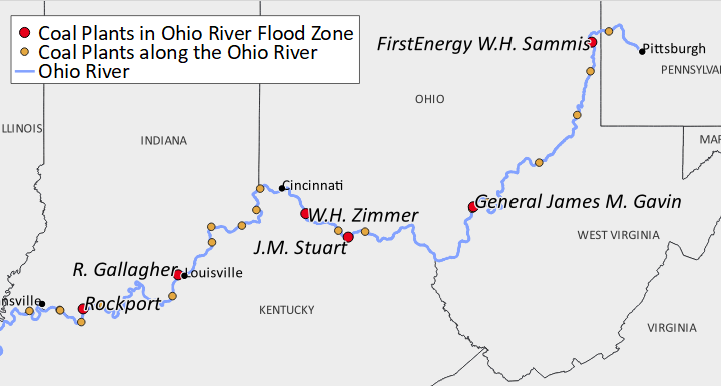Note: A newer version of this report is available.
Clean water is essential to America’s health and welfare. Our lakes, rivers, streams and creeks provide us with water to drink, add character to our most beautiful natural places, and give us places to fish and swim.
Unfortunately, our waterways are under constant threat of pollution from dangerous facilities located along their banks. These facilities are accidents waiting to happen.
Coal ash ponds store billions of gallons of coal plant ash waste – residual from burning coal that is mixed with water for storage – which is often highly toxic. Despite numerous instances of catastrophic damage resulting from coal ash spills, these toxic sites continue to put our waterways at risk of spills and accidents.
To protect our waterways from coal ash spills and contamination, policymakers must work to reduce our dependence on coal, while ensuring that coal ash ponds are highly regulated and kept far from the water’s edge.
Toxic coal ash ponds pose acute threats to America’s major rivers and lakes.
- Coal ash ponds are inherently risky.
- Coal ash is highly toxic, containing pollutants that can damage the circulatory, respiratory and digestive systems and lead to neurological and reproductive problems. In the environment, pollutants in coal ash like selenium can bioaccumulate and cause long-term damage to wildlife populations.
- As most coal-fired power plants are located next to bodies of water for cooling, coal ash ponds are often located along rivers and lakes, sometimes separated from waterways by only a thin retaining wall.
- In 2016, coal plants produced 107 million tons of ash, of which nearly half (47 million tons) was left over as waste and not used for other industrial processes.
- Coal ash ponds have a history of devastating spills and groundwater contamination.
- As of 2014, the organization EarthJustice had found evidence of 208 cases of coal ash spills and contamination in the U.S.
- In 2008, a coal ash pond at the Kingston Plant in Tennessee spilled 5.4 million cubic yards of coal ash waste. Following the spill, sediment samples were devoid of life, and fish were found with elevated levels of toxic selenium and mercury. Even after the completion of a seven-year, billion-dollar cleanup effort, more than 500,000 cubic yards of coal ash remained in the river.
- Coal ash ponds present active threats to American waterways.
- In the U.S., at least 14 coal plants with on-site coal ash ponds are located within Federal Emergency Management Agency (FEMA) 100-year flood zones, an indicator of proximity to water and potential for damage to waterways. These plants generate 8.4 million tons of coal ash each year. They are also home to at least 36 coal ash ponds, including eight that were found to be in poor condition according to a 2014 U.S. Environmental Protection Agency (EPA) assessment.
- Six coal plants lie in FEMA flood zones along the Ohio River, including five with coal ash ponds that the EPA found pose a “high” or “significant” hazard.
Figure ES-1. Coal Plants in 100-Year Flood Zones Along the Ohio River
Six coal plants lie in FEMA 100-year flood zones along the Ohio River. All have coal ash ponds on site, including four with coal ash ponds rated as “significant” hazards by a 2014 EPA assessment. Many more coal plants not in flood zones also sit along the banks of the Ohio River.
To protect our waterways, all levels of governments should strictly regulate activities that involve the production and storage of coal ash, and ensure that, to the extent those activities occur, they take place far from water. Policymakers should:
- Establish a moratorium on all new or expanded coal ash ponds.
- Close existing coal ash ponds as quickly as is safely possible, putting highest priority on coal ash ponds that pose a threat to waterways and coal ash ponds that are unlined.
- Coal ash ponds should be excavated and their contents stored in lined, monitored landfills located away from waterways.
- Ensure that, until they are closed, coal ash ponds are tightly regulated to protect against spills and contamination, and that such regulations are diligently enforced. Regulations should ensure that:
- Coal ash ponds meet strict standards for leak prevention and structural integrity.
- Surrounding groundwater and waterways are continuously monitored for contamination.
- Coal ash ponds are frequently checked for leaks and problems with structural integrity.
- The public is kept informed of any threats to drinking water or waterways.
- All coal ash pollution is tightly regulated and monitored, whether it flows directly into surface waters or into groundwater.
- Work to rapidly replace coal-fired and other fossil fuel power plants with clean energy sources like solar panels, wind turbines and improvements in energy efficiency.

